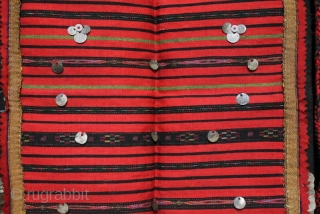Back
a late 19th century Bulgarian pristilka apron from the Vratsa region with over 160 Ottoman silver alloy coins stitched along the side and bottom edges and front. Very finely woven flat weave with metallic thread, gold brocade ribbons and plaited tied chords. 30 inches long by 16 inches wide.
The tradition of sewing coins onto women's garments goes back to ancient times. Traditionally, as well as from eastern European countries, men from the Greek Islands would go on migration to the Ottoman empire to seek work and on returning home, would hand over a portion of their earnings to their wives who would sew the gold and silver coins onto their festival costumes and head dresses, which would become dowry treasures.
See for example the Island of the village of Olymbos in Karpathos where many women still have costumes with centuries old solid gold coins attached. The tradition developed into a decorative folk practice with purely symbolic significance as lower denomination coins began to be used without such great financial value.
For more photos see: http://www.kilim.ie/TRIBAL_RUGS_and_KILIMS/Pages/BULGARIAN_AND_OTTOMAN.html
Please email me for more information.
price:
Please enquire
- Home
- Antique Rugs by Region
- Category
- Profiles
- Post Items Free
- Albums
- Benaki Museum of Islamic Art
- Budapest: Ottoman Carpets
- Gulbenkian Museum
- Islamic Carpets. Brooklyn
- Islamic Textiles. Brooklyn
- Konya Museum: Rugs
- MKG, Hamburg
- MMA: Caucasian Carpets
- MMA: Mamluk Carpets
- MMA: Mughal Indian Carpets
- MMA: Ottoman Carpets
- MMA: Safavid Persian Carpets
- MMA: Turkmen Rugs
- McCoy Jones Kilims
- Ottoman textiles. Met
- Philadelphia Museum
- Rugs and Carpets: Berlin
- Seljuqs at the Met
- TIEM, Istanbul: Carpets
- V&A: Classical Carpets
- Vakiflar Carpets: Istanbul
- Baluch Rugs: Indianapolis
- Gallery Exhibitions
- Jaf an Exhibition
- Alberto Levi Gallery
- Andean Textile
- Christie's London: 2016
- Francesca Galloway
- HALI at 40
- ICOC Washington, DC 2018
- Jajims of the Shahsavan
- London Islamic Week April, 2018
- Mongolian Felts
- Navajo Rugs: JB Moore
- Persian Piled Weavings
- SF Tribal & Textile Art Show 2020
- SF Tribal 2019
- Sotheby's: C. Alexander
- Turkish Prayer Rugs
- Turkmen Main Carpets ICOC 2007













